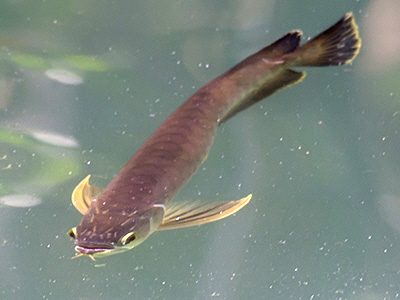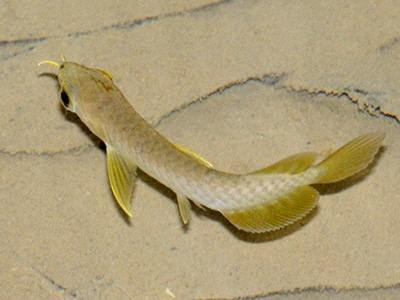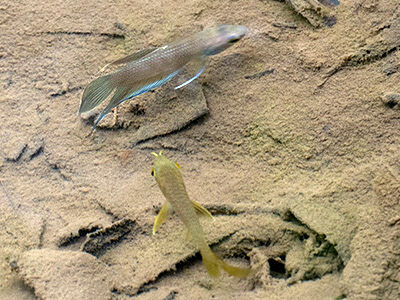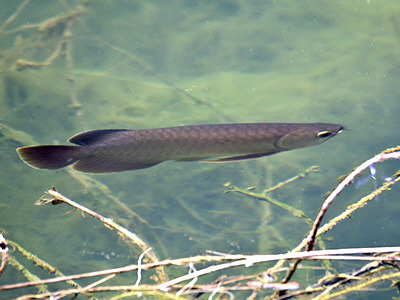
Fig 1

Fig 2

Fig 3

Fig 4

Fig 5
|
Order : Osteoglossiformes
Family : OSTEOGLOSSIDAE
Species : Scleropages formosus
Maximum Length : 90 cm
The Asian Arowana, or Dragonfish, is a
member of a small group of ancient fishes called bonytongues. At
least three other species of the genus are recognised, two of which
occur in Australia, and another which was described from Myanmar
in 2012 (Roberts, 2012). The latter, Scleropages inscriptus, is similar in form
to Scleropages formosus but its head and body is adorned with
complex markings in a maze-like pattern.
The species occurs in blackwater habitats with acidic water
such as swamps, wetlands and slow-flying rivers. They are surface
feeders : adults are carnivorous and feed on other species of fish and large insects,
while juveniles feed on small insects.
Adult males adopt the role of mouthbrooder, caring
for fertlised eggs and hatchlings in their mouth for many weeks.
Their bodies are elongate, with a rounded tail fin and large dorsal,
pectoral and anal fins. The lower jaw bears two, short barbels. Their
scales are large.
There are a number of colour varieties in different regions, including
green, silver, red and golden.
The species fetches a high price as an ornamental fish, particularly
amongst Chinese communities : the international trade in arowanas has put
great pressure on native populations, which are over-harvested in many
countries.
The Asian Arowana occurs naturally in southern Myanmar, Thailand,
Cambodia, Vietnam, Peninsular Malaysia, Sumatra and Borneo and Bangka. In Singapore
the species has been introduced to reservoirs, and appears to have
established breeding populations in inland waterbodies.
Fig 1 : Yellow-tailed, silver variety, which is typically dark grey on the
back.
Figs 2 and 3 : Yellow juvenile from Singapore, found in a shallow forest
stream. The other species in Figure 3 is a
Forest Betta Betta pugnax.
Fig 4 : Specimen from Macritchie Reservoir, Singapore.
Fig 5 : Specimen from Sungei Buloh, Singapore with golden scales on the
flanks and reddish fins.
References :
Lim, K.P. and Ng, K.L. 1990. A Guide to the Freshwater Fishes of
Singapore. Singapore Science Centre.
Roberts, T. R. (2012). Scleropages inscriptus, a new fish species
from the Tananthayi or Tenasserim River basin, Malay Peninsula of
Myanmar (Osteoglossidae: Osteoglossiformes). Aqua: International
Journal of Ichthyology 18.2 (2012): 113
Links :
Lim, K. K. P. & N. Baker (2013). Juvenile Asian Arowana at Lower Peirce.
Singapore Biodiversity Records. Lee Kong Chian Natural History Museum.
2013 : 21.
Ng, H. H., & Tan, H. H. (2010). An annotated checklist of the non-native
freshwater fish species in the reservoirs of Singapore. Cosmos, 6(01),
95-116.
|